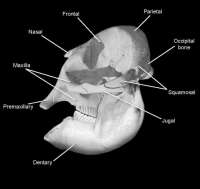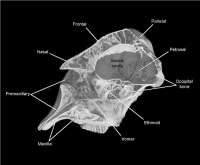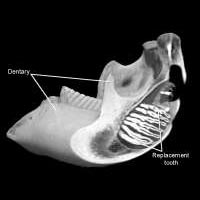The current geographic range of the Asian elephant, Elephas maximus, includes Indochina, Malaysia, Indonesia, southern China, and the Indian subcontinent. Within this extensive range, the Asian elephant utilizes a diversity of habitats that include thick jungles to open grassy plains. Although the current distribution of the Asian elephant is considerable, this species historically roamed from Iraq to northern China. The current retraction of geographic range reflects diminishing population numbers. The Asian elephant presently is listed as endangered by CITES. |
|
 |
The Asian elephant, Elephas maximus, and the African elephant, Loxodontia africana are the only elephant species remaining from a once diverse group, the Proboscidea. The Asian elephant can be distinguished from the African form by its smaller size, smaller ears, convexly curved back, flattened forehead, and the presence of one instead of two lips on the distal end of the trunk.
|
Lateral view

 |
The elephant skull is disproportionately large compared to the size of its brain. The oversized skull is necessary to support the large and complex musculature used to manipulate the trunk. The presence of numerous cavities and air cells within the skull, however, considerably lighten the overall weight.
|
Sagittal section


 |
The dentition of elephants is unique. The canine teeth are lost so that only the incisors, premolars, and molars are retained. The pattern of replacement of the molariform teeth resembles a conveyor belt with teeth emerging at the back of the mouth and then being pushed forward. Mastication is performed using only one molariform tooth per quadrant. As one tooth is worn down, another pushes forward to take its place and the worn tooth is spit out. When the last molar is worn down, the elephant becomes highly susceptible to starvation.
|
Mandible 

About the Species
This specimen is the skull of a juvenile male. It was made available to The University of Texas High-Resolution X-ray CT Facility for scanning by Dr. Timothy Rowe of The University of Texas at Austin, courtesy of the Texas Memorial Museum's Vertebrate Paleontology Laboratory. Funding for scanning was provided by a National Science Foundation Digital Libraries Initiative grant to Dr. Rowe.

About this Specimen
This specimen was scanned at the Heart Hospital of Austin on 7 April 2003, on Imatron C-150 XP/LP "ultra fast" CT. The skull was scanned resting on its dorsal face on top of a padded surface. This surface was removed digitally; therefore, some roughness may be seen on the dorsal side of the specimen. It was scanned along the coronal axis for a total of 350 slices. Interslice spacing is 0.2011 mm and the field of reconstruction is 470.0 mm.

About the
Scan
Literature
Macdonald, D. 1984. The Encyclopedia of Mammals. Facts on File Publications, New York, 895 pp.
Nowak, R. M. 1999. Walker's Mammals of the World, 6th ed. The Johns Hopkins University Press, Baltimore, 1936 pp.
Van der Merwe, R. J., A. J. Bezuidenhout, and C. D. Seegers. 1995. The skull and mandible of the African elephant (Loxodonta africana). The Onderstepoort Journal of Veterinary Research 62: 245-260.
Links
Mammalian Species account of Elephas maximus (American Society of Mammalogists)
Elephas maximus on The Animal Diversity Web (The University of Michigan Museum of Zoology)
Elephas maximus on CITES-listed species database
See more images of elephants from Last Refuge Ltd.

Literature
& Links
None available.

Additional
Imagery
|

